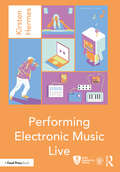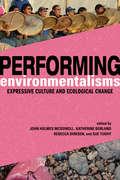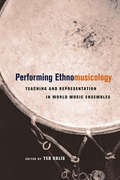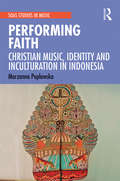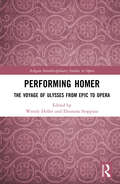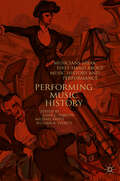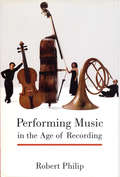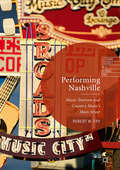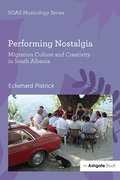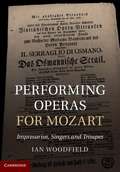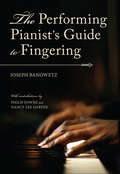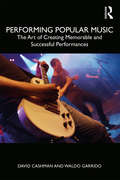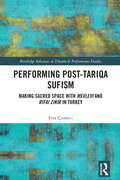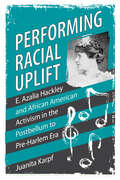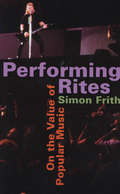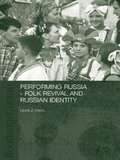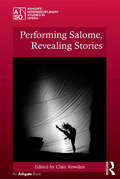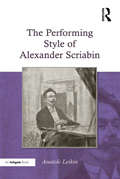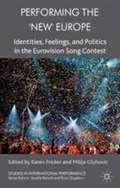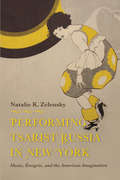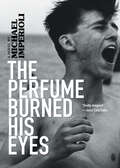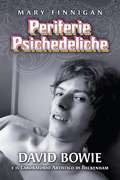- Table View
- List View
Performing Electronic Music Live (Audio Engineering Society Presents)
by Kirsten HermesPerforming Electronic Music Live lays out conceptual approaches, tools, and techniques for electronic music performance, from DJing, DAWs, MIDI controllers, traditional instruments, live sound design, hardware setups, custom software and hardware, to live visuals, venue acoustics, and live show promotion. Through case studies and contrasting tutorials by successful artists, Kirsten Hermes explores the many different ways in which you can create memorable experiences on stage. Featuring interviews with highly accomplished musicians and practitioners, readers can also expand on their knowledge with hands-on video tutorials for each chapter via the companion website, performingelectronicmusic.live. Performing Electronic Music Live is an essential, all-encompassing resource for professionals, students of music production courses, and researchers in the field of creative-focused performance technology.
Performing Environmentalisms: Expressive Culture and Ecological Change
by Aaron S. Allen Eduardo S Brondizio Assefa Tefera Dibaba Rebecca Dirksen Mary Hufford John Holmes McDowell Mark Pedelty Jennifer C. Post Chie Sakakibara Jeff Todd Titon Rory Turner Lois WilckenPerforming Environmentalisms examines the existential challenge of the twenty-first century: improving the prospects for maintaining life on our planet. The contributors focus on the strategic use of traditional artistic expression--storytelling and songs, crafted objects, and ceremonies and rituals--performed during the social turmoil provoked by environmental degradation and ecological collapse. Highlighting alternative visions of what it means to be human, the authors place performance at the center of people's responses to the crises. Such expression reinforces the agency of human beings as they work, independently and together, to address ecological dilemmas. The essays add these people's critical perspectives--gained through intimate struggle with life-altering force--to the global dialogue surrounding humanity's response to climate change, threats to biocultural diversity, and environmental catastrophe. Interdisciplinary in approach and wide-ranging in scope, Performing Environmentalisms is an engaging look at the merger of cultural expression and environmental action on the front lines of today's global emergency. Contributors: Aaron S. Allen, Eduardo S. Brondizio, Assefa Tefera Dibaba, Rebecca Dirksen, Mary Hufford, John Holmes McDowell, Mark Pedelty, Jennifer C. Post, Chie Sakakibara, Jeff Todd Titon, Rory Turner, Lois Wilcken
Performing Ethnomusicology: Teaching and Representation in World Music Ensembles
by Ted SolisPerforming Ethnomusicology is the first book to deal exclusively with creating, teaching, and contextualizing academic world music performing ensembles. Considering the formidable theoretical, ethical, and practical issues that confront ethnomusicologists who direct such ensembles, the sixteen essays in this volume discuss problems of public performance and the pragmatics of pedagogy and learning processes. Their perspectives, drawing upon expertise in Caribbean steelband, Indian, Balinese, Javanese, Philippine, Mexican, Central and West African, Japanese, Chinese, Middle Eastern, and Jewish klezmer ensembles, provide a uniquely informed and many-faceted view of this complicated and rapidly changing landscape. The authors examine the creative and pedagogical negotiations involved in intergenerational and intercultural transmission and explore topics such as reflexivity, representation, hegemony, and aesthetically determined interaction. Performing Ethnomusicology affords sophisticated insights into the structuring of ethnomusicologists' careers and methodologies. This book offers an unprecedented rich history and contemporary examination of academic world music performance in the West, especially in the United States. "Performing Ethnomusicology is an important book not only within the field of ethnomusicology itself, but for scholars in all disciplines engaged in aspects of performance--historical musicology, anthropology, folklore, and cultural studies. The individual articles offer a provocative and disparate array of threads and themes, which Solís skillfully weaves together in his introductory essay. A book of great importance and long overdue."--R. Anderson Sutton, author of Calling Back the Spirit Contributors: Gage Averill, Kelly Gross, David Harnish, Mantle Hood, David W. Hughes, Michelle Kisliuk, David Locke, Scott Marcus, Hankus Netsky, Ali Jihad Racy, Anne K. Rasmussen, Ted Solís, Hardja Susilo, Sumarsam, Ricardo D. Trimillos, Roger Vetter, J. Lawrence Witzleben
Performing Faith: Christian Music, Identity and Inculturation in Indonesia (SOAS Studies in Music Series)
by Marzanna PoplawskaThis book is a study of music inculturation in Indonesia. It shows how religious expression can be made relevant in an indigenous context and how grassroots Christianity is being realized by means of music. Through the discussion of indigenous expressions of Christianity, the book presents multiple ways in which Indonesians reiterate their identity through music by creatively forging Christian and indigenous elements. This study moves beyond the discussion (and charge) of syncretism, showing that the inclusion of local cultural manifestations is an answer to creating a truly indigenous Christian expression. Marzanna Poplawska, while telling the story of Indonesian Christians and the multiple ways in which they live Christianity through music, emphasizes the creative energy and agency of local people. In their practices she finds optimism for the continuing existence of many traditional genres and styles. Indonesian Christians perform their Christian faith through music, dance, and theater, generating innovative cultural products that enrich the global Christian heritage. The book is addressed to a broad spectrum of readers: scholars from a variety of disciplines – music, religion, anthropology, especially those interested in interactions between Christianity and indigenous cultures; general music lovers and World Music enthusiasts eager to discover musics outside of European realm; as well as Christian believers, church musicians, and choir directors curious to learn about Christian music beyond Euro-American context. Students of religion, sacred music, (ethno)musicology, theater, and dance will also benefit from learning about a variety of indigenous arts employed in Christian churches in Indonesia.
Performing Homer: The Voyage Of Ulysses From Epic To Opera (Ashgate Interdisciplinary Studies in Opera)
by Wendy Heller Eleonora StoppinoThe epic poems the Iliad and the Odyssey, attributed to Homer, are among the oldest surviving works of literature derived from oral performance. Deeply embedded in these works is the notion that they were intended to be heard: there is something musical about Homer's use of language and a vivid quality to his images that transcends the written page to create a theatrical experience for the listener. Indeed, it is precisely the theatrical quality of the poems that would inspire later interpreters to cast the Odyssey and the Iliad in a host of other media-novels, plays, poems, paintings, and even that most elaborate of all art forms, opera, exemplified by no less a work than Monteverdi's Il ritorno di Ulisse in patria. In Performing Homer: The Voyage of Ulysses from Epic to Opera, scholars in classics, drama, Italian literature, art history, and musicology explore the journey of Homer's Odyssey from ancient to modern times. The book traces the reception of the Odyssey though the Italian humanist sources—from Dante, Petrarch, and Ariosto—to the treatment of the tale not only by Monteverdi but also such composers as Elizabeth Jacquet de la Guerre, Gluck, and Alessandro Scarlatti, and the dramatic and poetic traditions thereafter by such modern writers as Derek Walcott and Margaret Atwood.
Performing Music History: Musicians Speak First-Hand about Music History and Performance
by John C. Tibbetts Michael Saffle William A. EverettPerforming Music History offers a unique perspective on music history and performance through a series of conversations with women and men intimately associated with music performance, history, and practice: the musicians themselves. Fifty-five celebrated artists—singers, pianists, violinists, cellists, flutists, horn players, oboists, composers, conductors, and jazz greats—provide interviews that encompass most of Western music history, from the Middle Ages to contemporary classical music, avant-garde innovations, and Broadway musicals. The book covers music history through lenses that include “authentic” performance, original instrumentation, and social context. Moreover, the musicians interviewed all bring to bear upon their respective subjects three outstanding qualities: 1) their high esteem in the music world as immediately recognizable names among musicians and public alike; 2) their energy and devotion to scholarship and the recovery of endangered musical heritages; and 3) their considerable skills, media savvy, and showmanship as communicators. Introductory essays to each chapter provide brief synopses of historical eras and topics. Combining careful scholarship and lively conversation, Performing Music History explores historical contexts for a host of fascinating issues.
Performing Music in the Age of Recording
by Robert PhilipListeners have enjoyed classical music recordings for more than a century, yet important issues about recorded performances have been little explored. What is the relationship between performance and recording? How are modern audiences affected by the trends set in motion by the recording era? What is the impact of recordings on the lives of musicians? In this wide-ranging book, Robert Philip extends the scope of his earlier pioneering book, Early Recordings and Musical Style: Changing Tastes in Instrumental Performance 1900-1950. Philip here considers the interaction between music-making and recording throughout the entire twentieth century. The author compares the lives of musicians and audiences in the years before recordings with those of today. He examines such diverse and sometimes contentious topics as changing attitudes toward freedom of expression, the authority of recordings made by or approved by composers, the globalization of performing styles, and the rise of the period instrument movement. Philip concludes with a thought-provoking discussion of the future of classical music performance.
Performing Nashville
by Robert W. FryThis book explores the formation and continuance of Nashville, Tennessee as a music place, the importance of the fans (tourists) in creating Nashville's multifaceted musical identity, and the music and city's influence on the formation and performance of the individual and collective identities of the country-music fan. More importantly, the author discusses the larger issue of country music as a signifier of tradition suggesting that for many visitors, the music serves as a soundtrack, while Nashville serves as a performative space that permits the creation, performance, and remembrance of not only the country-music tradition, but also various individual and collective traditions and an idealized American identity. Through the theatrics of tourism, Nashville and its connection to country music are performed daily, reinforced through the sound and landscape of country music. Performing Nashville will be of interest to students and scholars across a range of disciplines, including tourism studies, leisure studies, ethnomusicology, sociology, folklore and anthropology.
Performing Nostalgia: Migration Culture And Creativity In South Albania (Soas Musicology Ser.)
by Eckehard PistrickMigration studies is an area of increasing significance in musicology as in other disciplines. How do migrants express and imagine themselves through musical practice? How does music help them to construct social imaginaries and to cope with longings and belongings? In this study of migration music in postsocialist Albania, Eckehard Pistrick identifies links between sound, space, emotionality and mobility in performance, provides new insights into the controversial relationship between sound and migration, and sheds light on the cultural effects of migration processes. Central to Pistrick�s approach is the essential role of emotionality for musical creativity which is highlighted throughout the volume: pain and longing are discussed not as a traumatising end point, but as a driving force for human action and as a source for cultural creativity. In addition, the study provides a fascinating overview about the current state of a rarely documented vocal tradition in Europe that is a part of the mosaic of Mediterranean singing traditions. It refers to the challenges imposed onto this practice by heritage politics, the dynamics of retraditionalisation and musical globalisation. In this sense the book constitutes an important study to the dynamics of postsocialism as seen from a musicological perspective.
Performing Operas for Mozart: Impresarios, Singers and Troupes
by Ian WoodfieldThe Italian opera company in Prague managed by Pasquale Bondini and Domenico Guardasoni played a central role in promoting Mozart's operas during the final years of his life. Using a wide range of primary sources which include the superb collections of eighteenth-century opera posters and concert programmes in Leipzig and the Indice de' teatrali spettacoli, an almanac of Italian singers and dancers, this study examines the annual schedules, recruitment networks, casting policies and repertoire selections of this important company. Woodfield shows how Italian-language performances of Figaro, Don Giovanni, Così fan tutte and La clemenza di Tito flourished along the well-known cultural axis linking Prague in Bohemia to Dresden and Leipzig in Saxony. The important part played by concert performances of operatic arias in the early reception of Mozart's works is also discussed and new information is presented about the reception of Josepha Duschek and Mozart in Leipzig.
Performing Operas for Mozart
by Ian WoodfieldThe Italian opera company in Prague managed by Pasquale Bondini and Domenico Guardasoni played a central role in promoting Mozart's operas during the final years of his life. Using a wide range of primary sources which include the superb collections of eighteenth-century opera posters and concert programmes in Leipzig and the Indice de' teatrali spettacoli, an almanac of Italian singers and dancers, this study examines the annual schedules, recruitment networks, casting policies and repertoire selections of this important company. Woodfield shows how Italian-language performances of Figaro, Don Giovanni, Cosi fan tutte and La clemenza di Tito flourished along the well-known cultural axis linking Prague in Bohemia to Dresden and Leipzig in Saxony. The important part played by concert performances of operatic arias in the early reception of Mozart's works is also discussed and new information is presented about the reception of Josepha Duschek and Mozart in Leipzig.
The Performing Pianist's Guide to Fingering
by Joseph BanowetzThe Performing Pianist's Guide to Fingering, the much-anticipated companion to Joseph Banowetz's The Pianist's Guide to Pedaling, provides practical fingering solutions for technical musical passages. Banowetz contends that fingering choices require much thought and consideration and that too often these choices are influenced by historical traditions and ideas rather than by actual performance conditions. By returning to the unedited original compositions, he strives to help the advanced pianist think through the composer's musical intent and the actual performance tempo and dynamics when selecting the fingering. Banowetz also includes valuable contributions by Philip Fowke, who examines redistributions by Benno Moiseiwitsch in Rachmaninoff's compositions, and Nancy Lee Harper, who explores the often very different approaches to fingering found in keyboard music of the Baroque era. The Performing Pianist's Guide to Fingering will be useful to the advanced pianist and to instructors looking to guide students in improving this important art.
Performing Popular Music: The Art of Creating Memorable and Successful Performances
by David Cashman Waldo GarridoThis book explores the fundamentals of popular music performance for students in contemporary music institutions. Drawing on the insights of performance practice research, it discusses the unwritten rules of performances in popular music, what it takes to create a memorable performance, and live popular music as a creative industry. The authors offer a practical overview of topics ranging from rehearsals to stagecraft, and what to do when things go wrong. Chapters on promotion, recordings, and the music industry place performance in the context of building a career. Performing Popular Music introduces aspiring musicians to the elements of crafting compelling performances and succeeding in the world of today’s popular music.
Performing Post-Tariqa Sufism: Making Sacred Space with Mevlevi and Rifai Zikir in Turkey (Routledge Advances in Theatre & Performance Studies)
by Esra ÇizmeciThis ethnographic research project examines the generation of post-tariqa Tasavvuf (Sufism: a spiritual practice and philosophy recognised as the inner dimension of Islam) in a variety of private, semi-public, public, secular and sacred urban spaces in present-day Turkey. Through extensive field research in minority Sufi communities, this book investigates how devotees of specific orders maintain, adapt, mobilise, and empower their beliefs and values through embodied acts of their Sufi followers. Using an ethnographic methodology and theories derived from performance studies, Esra Çizmeci examines the multiple ways in which the post-tariqa Mevlevi and Rifai practice is formed in present-day Turkey, such as through the authority of the spiritual teacher; the individual and collective performance of Sufi rituals; nefs (self) training; and, most importantly, the practice of Sufi doctrines in everyday life through the production of sacred spaces. Drawing on the theories of performance, she examines how the Sufi way of living and spaces are created anew in the process of each devotee’s embodied action. This book is informed by theories in performance studies, anthropology, religious studies, and cultural studies and places current Sufi practices in a historical perspective.
Performing Racial Uplift: E. Azalia Hackley and African American Activism in the Postbellum to Pre-Harlem Era (Margaret Walker Alexander Series in African American Studies)
by Juanita Karpf2023 CHOICE Outstanding Academic TitleIn Performing Racial Uplift: E. Azalia Hackley and African American Activism in the Postbellum to Pre-Harlem Era, Juanita Karpf rediscovers the career of Black activist E. Azalia Hackley (1867–1922), a concert artist, nationally famous music teacher, and charismatic lecturer. Growing up in Black Detroit, she began touring as a pianist and soprano soloist while only in her teens. By the late 1910s, she had toured coast-to-coast, earning glowing reviews. Her concert repertoire consisted of an innovative blend of spirituals, popular ballads, virtuosic showstoppers, and classical pieces. She also taught music while on tour and visited several hundred Black schools, churches, and communities during her career. She traveled overseas and, in London and Paris, studied singing with William Shakespeare and Jean de Reszke—two of the classical music world’s most renowned teachers. Her acceptance into these famous studios confirmed her extraordinary musicianship, a “first” for an African American singer. She founded the Normal Vocal Institute in Chicago, the first music school founded by a Black performer to offer teacher training to aspiring African American musicians. Hackley’s activist philosophy was unique. Unlike most activists of her era, she did not align herself unequivocally with either Booker T. Washington or W. E. B. Du Bois. Instead, she created her own mediatory philosophical approach. To carry out her agenda, she harnessed such strategies as giving music lessons to large audiences and delivering lectures on the ecumenical religious movement known as New Thought. In this book, Karpf reclaims Hackley's legacy and details the talent, energy, determination, and unprecedented worldview she brought to the cause of racial uplift.
Performing Rites: On the Value of Popular Music
by Simon FrithWho's better? Billie Holiday or P. J. Harvey? Blur or Oasis? Dylan or Keats? And how many friendships have ridden on the answer? Such questions aren't merely the stuff of fanzines and idle talk; they inform our most passionate arguments, distill our most deeply held values, make meaning of our ever-changing culture. In Performing Rites, one of the most influential writers on popular music asks what we talk about when we talk about music. What's good, what's bad? What's high, what's low? Why do such distinctions matter? Instead of dismissing emotional response and personal taste as inaccessible to the academic critic, Simon Frith takes these forms of engagement as his subject--and discloses their place at the very center of the aesthetics that structure our culture and color our lives. Taking up hundreds of songs and writers, Frith insists on acts of evaluation of popular music as music. Ranging through and beyond the twentieth century, Performing Rites puts the Pet Shop Boys and Puccini, rhythm and lyric, voice and technology, into a dialogue about the undeniable impact of popular aesthetics on our lives. How we nod our heads or tap our feet, grin or grimace or flip the dial; how we determine what's sublime and what's "for real"--these are part of the way we construct our social identities, and an essential response to the performance of all music. Frith argues that listening itself is a performance, both social gesture and bodily response. From how they are made to how they are received, popular songs appear here as not only meriting aesthetic judgments but also demanding them, and shaping our understanding of what all music means.
Performing Rites: On the Value of Popular Music
by Simon FrithAn influential writer on popular music asks what we talk about when we talk about music. Instead of dismissing emotional response and personal taste as inaccessible to academic critics, Frith takes these forms of engagement as his subject—and discloses their place at the center of the aesthetics that structure our culture and color our lives.
Performing Russia: Folk Revival and Russian Identity (BASEES/Routledge Series on Russian and East European Studies)
by Laura OlsonThis book examines folk music and dance revival movements in Russia, exploring why this folk culture has come to represent Russia, how it has been approached and produced, and why memory and tradition, in these particular forms, have taken on particular significance in different periods. Above all it shows how folk "tradition" in Russia is an artificial cultural construct, which is periodically reinvented, and it demonstrates in particular how the "folk revival" has played a key role in strengthening Russian national consciousness in the post-Soviet period.
Performing Salome, Revealing Stories (Ashgate Interdisciplinary Studies in Opera)
by Clair RowdenWith its first public live performance in Paris on 11 February 1896, Oscar Wilde's Salomé took on female embodied form that signalled the start of 'her' phenomenal journey through the history of the arts in the twentieth century. This volume explores Salome's appropriation and reincarnation across the arts - not just Wilde's heroine, nor Richard Strauss's - but Salome as a cultural icon in fin-de-siècle society, whose appeal for ever new interpretations of the biblical story still endures today. Using Salome as a common starting point, each chapter suggests new ways in which performing bodies reveal alternative stories, narratives and perspectives and offer a range and breadth of source material and theoretical approaches. The first chapter draws on the field of comparative literature to investigate the inter-artistic interpretations of Salome in a period that straddles the end of the nineteenth century and the beginning of the Modernist era. This chapter sets the tone for the rest of the volume, which develops specific case studies dealing with censorship, reception, authorial reputation, appropriation, embodiment and performance. As well as the Viennese premiere of Wilde's play, embodied performances of Salome from the period before the First World War are considered, offering insight into the role and agency of performers in the production and complex negotiation of meaning inherent in the role of Salome. By examining important productions of Strauss's Salome since 1945, and more recent film interpretations of Wilde's play, the last chapters explore performance as a cultural practice that reinscribes and continuously reinvents the ideas, icons, symbols and gestures that shape both the performance itself, its reception and its cultural meaning.
The Performing Style of Alexander Scriabin
by Anatole LeikinWhen Alexander Nikolayevich Scriabin's music was performed during his lifetime, it always elicited ecstatic responses from the listeners. Wilhelm Gericke, conductor of the Vienna opera, rushed backstage after one of Scriabin's concerts and fell on his knees crying, 'It's genius, it's genius...'. After the composer’s death in 1915, however, his music steadily lost the captivating appeal it once held. The main reason for this drastic change in the listeners’ attitude is an enormous gap existing between the printed scores of Scriabin’s music and the way the composer himself played his works. Apparently, what Scriabin's audiences heard at the time was significantly different from, and vastly superior to, modern performances that are based primarily on published scores. Scriabin recorded nineteen of his compositions on the Hupfeld and Welte-Mignon reproducing pianos in 1908 and 1910, respectively. Full score transcriptions of the piano rolls, which are included in the book, provide many substantial features of Scriabin's performance: exact pitches and their timing against each other, rhythms, tempo fluctuations, articulation, dynamics and essential pedal application. Using these transcriptions and other historical documents as the groundwork for his research, Anatole Leikin explores Scriabin's performing style within the broader context of Romantic performance practice.
Performing the 'New' Europe
by Karen Fricker Milija GluhovicThis fascinating and lively volume makes the case that the Eurovision Song Contest is an arena for European identification in which both national solidarity and participation in a European identity are confirmed, and a site where cultural struggles over the meanings, frontiers and limits of Europe are enacted.
Performing Tsarist Russia in New York: Music, Émigrés, and the American Imagination (Russian Music Studies)
by Natalie K. ZelenskyAn examination of the popular music culture of the post-Bolshevik Russian emigration and the impact made by this group on American culture and politics.Performing Tsarist Russia in New York begins with a rich account of the musical evenings that took place in the Russian émigré enclave of Harlem in the 1920s and weaves through the world of Manhattan’s Russian restaurants, Tin Pan Alley industry, Broadway productions, 1939 World’s Fair, Soviet music distributors, postwar Russian parish musical life, and Cold War radio programming to close with today’s Russian ball scene, exploring how the idea of Russia Abroad has taken shape through various spheres of music production in New York over the course of a century. Engaging in an analysis of musical styles, performance practice, sheet music cover art, the discourses surrounding this music, and the sonic, somatic, and social realms of dance, author Natalie K. Zelensky demonstrates the central role played by music in shaping and maintaining the Russian émigré diaspora over multiple generations as well as the fundamental paradox underlying this process: that music’s sustaining power in this case rests on its proclivity to foster collective narratives of an idealized prerevolutionary Russia while often evolving stylistically to remain relevant to its makers, listeners, and dancers. By combining archival research with fieldwork and interviews with Russian émigrés of various generations and emigration waves, Zelensky presents a close historical and ethnographic examination of music’s potential as an aesthetic, discursive, and social space through which diasporans can engage with an idea of a mythologized homeland, and, in turn, the vital role played by music in the organization, development, and reception of Russia Abroad.
Performing Tsarist Russia in New York: Music, Émigrés, and the American Imagination (Russian Music Studies)
by Natalie K. ZelenskyAn examination of the popular music culture of the post-Bolshevik Russian emigration and the impact made by this group on American culture and politics.Performing Tsarist Russia in New York begins with a rich account of the musical evenings that took place in the Russian émigré enclave of Harlem in the 1920s and weaves through the world of Manhattan’s Russian restaurants, Tin Pan Alley industry, Broadway productions, 1939 World’s Fair, Soviet music distributors, postwar Russian parish musical life, and Cold War radio programming to close with today’s Russian ball scene, exploring how the idea of Russia Abroad has taken shape through various spheres of music production in New York over the course of a century. Engaging in an analysis of musical styles, performance practice, sheet music cover art, the discourses surrounding this music, and the sonic, somatic, and social realms of dance, author Natalie K. Zelensky demonstrates the central role played by music in shaping and maintaining the Russian émigré diaspora over multiple generations as well as the fundamental paradox underlying this process: that music’s sustaining power in this case rests on its proclivity to foster collective narratives of an idealized prerevolutionary Russia while often evolving stylistically to remain relevant to its makers, listeners, and dancers. By combining archival research with fieldwork and interviews with Russian émigrés of various generations and emigration waves, Zelensky presents a close historical and ethnographic examination of music’s potential as an aesthetic, discursive, and social space through which diasporans can engage with an idea of a mythologized homeland, and, in turn, the vital role played by music in the organization, development, and reception of Russia Abroad.
The Perfume Burned His Eyes
by Michael Imperioli"An edgy coming-of-age romp set in New York City."--Parade"Screenwriter and Emmy-winning actor Imperioli's first novel is the atmospheric coming-of-age story of 17-year-old Matthew, whose mother moves them from Queens to a posh apartment in Manhattan in 1976...Matt is not an atypical teenager--think Holden Caulfield without the cynicism--but, often afraid and awkward, he is a reactor, not an actor, until the end of the novel, which, without foreshadowing, comes as a harrowing surprise...Imperioli can definitely write, and he gets high marks for the verisimilitude and empathy that he evokes in this fine crossover novel."--Booklist, Starred Review"Imperioli's book follows a Queens teen named Matthew as his shattered family moves from Jackson Heights to Manhattan, where he finds an unlikely mentor in a drug-addled Lou Reed."--New York Post"A coming-of-age tale dashed with relatable angst and humor."--EW.com"A restless Queens teenager becomes the protégé of music legend Lou Reed in Imperioli's energetic debut novel...Matthew's first-person narrative is full of endearing vulnerability, immediacy, and authenticity. This is a sweet and nostalgic coming-of-age novel."--Publishers Weekly"Imperioli's lived-in details about the city help make the world feel realistic...[The novel] is an immersive trip into its narrator's memories of a turbulent time. Some fictional trips into 1970s New York abound with nostalgia; this novel memorably opts for grit and heartbreak."--Kirkus Reviews"Imperioli delivers a spot-on coming-of-age novel...A winner."--Library Journal"Even though [Lou] Reed looms large throughout--the novel even takes its title from Reed's 'Romeo Had Juliette,' from his 1989 solo album New York--the book is much less about him and more about Matthew's own journey through adolescence in the seedier corners of 1970s New York."--Stereogum"Compelling...Lou Reed appears as a major character; he's an unlikely father figure to the teenage protagonist, Matthew, who's trying to find himself in 1976 Manhattan. The iconoclastic--and at the time, troubled--rocker inspires Matthew artistically, even as he coaxes him to walk on the wild side."--Maclean's"[Imperioli's] debut novel, The Perfume Burned His Eyes, not only deserves an award for best title, but has garnered praise from Joyce Carol Oates...This should come as no surprise...Bravo!"--Santa Barbara MagazineMatthew is a sixteen-year-old living in Jackson Heights, Queens, in 1976. After he loses his two most important male role models, his father and grandfather, his mother uses her inheritance to uproot Matthew and herself to a posh apartment building in Manhattan. Although only three miles away from his boyhood home, "the city" is a completely new and strange world to Matthew.Matthew soon befriends (and becomes a quasi-assistant to) Lou Reed, who lives with his transgender girlfriend Rachel in the same building. The drug-addled, artistic/shamanic musician eventually becomes an unorthodox father figure to Matthew, who finds himself head over heels for the mysterious Veronica, a wise-beyond-her-years girl he meets at his new school.Written from the point of view of Matthew at age eighteen, two years after the story begins, the novel concludes with an epilogue in the year 2013, three days after Lou Reed's death, with Matthew in his fifties.
Periferie Psichedeliche
by Andrea Giampaoli Mary FinniganDavid Bowie ha ispirato decine di biografie sul suo genio musicale, ma nessuna mai così ricca di particolari - e di foto inedite - come quella degli esordi dell’artista nella periferia londinese raccontanti dalla giornalista Mary Finnigan in Psychedelic Suburbia – David Bowie and The Beckenham Arts Lab, pubblicato da Jorvik Press . É la storia di un giovanissimo Bowie, ancora sconosciuto, in cerca di ingaggi per concerti nei club di Londra. Mary Finnigan racconta di averlo accolto nella sua casa nel quartiere londinese di Beckenham, sostenendolo economicamente e di esserne divenuta la sua amante. Insieme fondarono un folk club al pub Three Tuns di Beckenham, organizzando riunioni settimanali alle quali man mano partecipavano sempre più persone tra poeti, studenti di cinema e altri creativi. Il club divenne un vero e proprio laboratorio artistico, The Beckenham Arts Lab, tra arti visive, teatro, poesia e musica, una Factory proprio come quella che stava creando Andy Warhol a New York. Il tutto culminerà nel Free Festival del 1696, evento che Bowie canterà nella famosa canzone "Memory of a Free Festival". Traduzione a cura di Andrea Giampaoli
